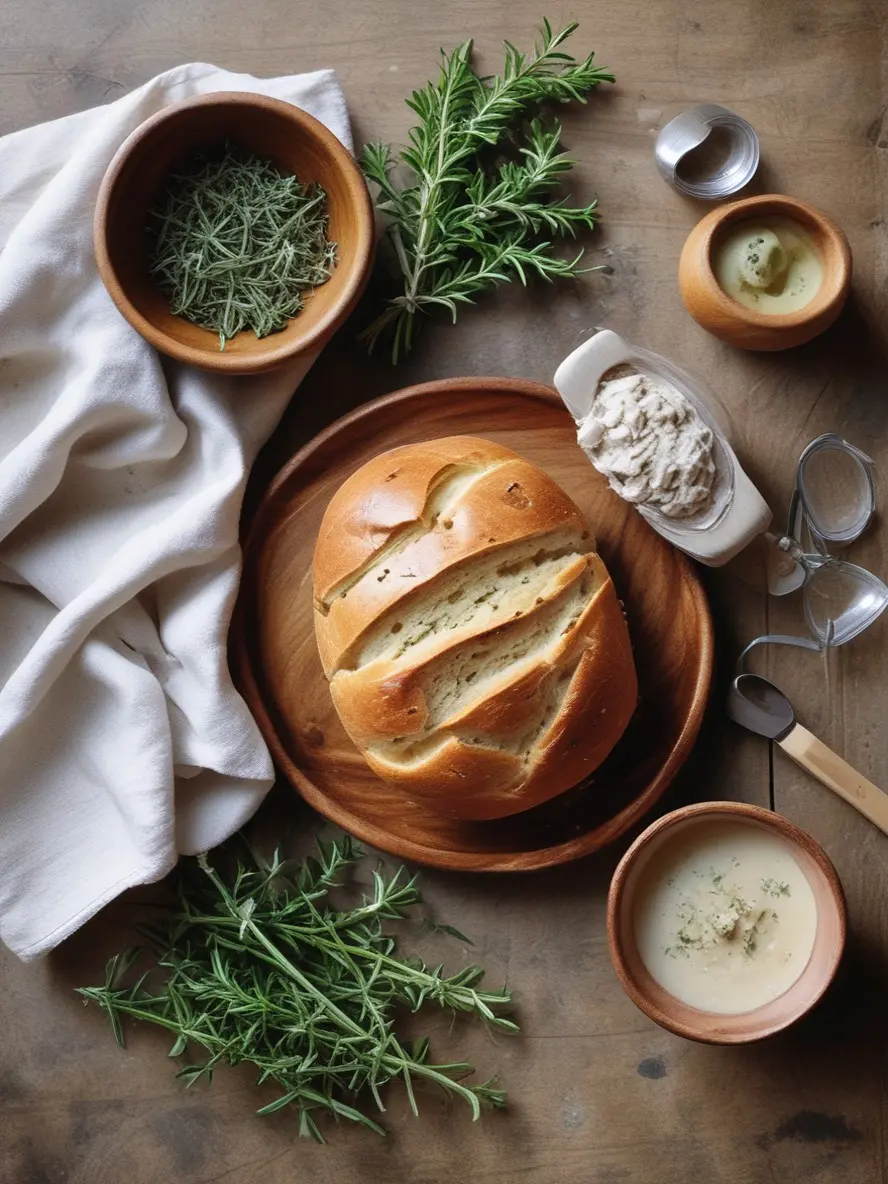Table of Contents
Imagine the warm, inviting aroma of freshly baked rosemary bread wafting through your home, wrapping you in a comforting embrace. Baking bread is not just about the ingredients; it’s about creating memories, sharing moments, and savoring the simple joys of life. Whether you’re a seasoned baker or a novice in the kitchen, the satisfaction of pulling a golden loaf from the oven is unparalleled. In this article, you’ll discover seven essential tips that will guide you in making the perfect rosemary bread, ensuring that every bite is a delightful experience.
Understanding Rosemary Bread
Rosemary bread is a delightful fusion of flavors that elevates any meal. This aromatic bread is often associated with Mediterranean cuisine, where fresh herbs play a pivotal role in enhancing taste. The use of rosemary, a fragrant herb known for its earthy and slightly pine-like flavor, adds a unique twist to traditional bread recipes.
Benefits of Using Fresh Rosemary in Baking
Using fresh rosemary in your bread not only enhances the flavor but also adds a touch of elegance. Fresh herbs contain essential oils that release their aromatic compounds during baking, creating a fragrant loaf that tantalizes your senses. Additionally, rosemary is packed with antioxidants and has anti-inflammatory properties, making your homemade bread not just delicious but also a bit healthier.
Essential Ingredients for Rosemary Bread
To create the perfect rosemary bread, you’ll need a few key ingredients. Each plays a vital role in the texture and flavor of your loaf. Here’s a list of what you’ll need:
| Ingredient | Quantity |
|---|---|
| All-purpose flour | 3 cups |
| Active dry yeast | 2 teaspoons |
| Warm water | 1 cup |
| Salt | 1 teaspoon |
| Fresh rosemary | 2 tablespoons (chopped) |
| Olive oil | 2 tablespoons |
Importance of Each Ingredient
- All-purpose flour: This is the foundation of your bread. It provides structure and texture.
- Active dry yeast: This ingredient is essential for fermentation, allowing your bread to rise and become fluffy.
- Warm water: Activates the yeast, helping it to grow and produce carbon dioxide, which makes the bread rise.
- Salt: Enhances flavor and controls yeast activity, ensuring a balanced taste.
- Fresh rosemary: Adds a fragrant and flavorful twist to your bread.
- Olive oil: Contributes to the moisture and richness of the bread.
Tip 1: Use Fresh Rosemary for Maximum Flavor
When it comes to rosemary bread, the quality of your ingredients matters. Fresh rosemary is a game-changer. It provides a vibrant flavor that dried rosemary simply cannot match. To prepare your rosemary, rinse it under cold water, pat it dry, and chop it finely. This will help release its essential oils, ensuring that every bite of your bread is infused with its aromatic goodness.
Tip 2: Measure Ingredients Accurately
Baking is a science, and precision is key. Accurate measurements ensure that your bread rises properly and has the right texture. Invest in a good kitchen scale for weighing ingredients, and use measuring cups for liquids. Remember, a little extra flour or water can significantly alter the outcome of your bread.
Tools for Measuring
- Kitchen scale: For precise measurements, especially for flour.
- Measuring cups: For liquids and dry ingredients.
- Measuring spoons: For small quantities like yeast and salt.
Tip 3: Knead the Dough Properly
Kneading is a crucial step in bread-making. It develops gluten, which gives your bread its structure and chewiness. When kneading, you want to work the dough until it becomes smooth and elastic. This usually takes about 8-10 minutes by hand or 5-7 minutes in a stand mixer.
Signs of Well-Kneaded Dough
- The dough should be smooth and elastic.
- It should spring back when you poke it with your finger.
- It should not be sticky; if it is, add a little more flour.
Tip 4: Allow for Proper Rising Time
Rising time is essential for developing flavor and texture in your bread. After kneading, place your dough in a lightly greased bowl, cover it with a damp cloth, and let it rise in a warm, draft-free area. The dough should double in size, which usually takes about 1 to 2 hours.
Ideal Conditions for Rising
- Temperature: A warm environment (around 75°F to 85°F) is ideal for yeast activity.
- Humidity: A slightly humid environment can help prevent the dough from drying out.
Tip 5: Preheat Your Oven
Preheating your oven is a critical step that many bakers overlook. A properly preheated oven ensures that your bread bakes evenly and develops a beautiful crust. For rosemary bread, preheat your oven to 375°F (190°C) at least 30 minutes before baking.
Why Preheating is Crucial
- It allows the yeast to continue working, giving your bread a good rise.
- It helps achieve a crispy crust while keeping the inside soft and fluffy.
Tip 6: Experiment with Add-ins
While rosemary bread is delicious on its own, don’t hesitate to get creative! Adding ingredients like garlic, cheese, or olives can elevate your bread to new heights. Here are some ideas to consider:
- Garlic: Add minced garlic for a savory twist.
- Cheese: Incorporate shredded cheese like Parmesan or mozzarella for a rich flavor.
- Olives: Chopped olives can add a briny contrast to the herbaceous rosemary.
Tip 7: Store Your Rosemary Bread Correctly
Once your rosemary bread is baked to perfection, it’s essential to store it properly to maintain its freshness. Here are some tips for storing your bread:
Best Practices for Storing Bread
- Room Temperature: Store your bread in a paper bag or wrapped in a clean kitchen towel to keep it fresh for a few days.
- Freezing: If you want to keep your bread longer, slice it and freeze it in an airtight container. When you’re ready to enjoy it, simply toast or reheat the slices.
Conclusion
Baking rosemary bread is a rewarding experience that brings warmth and flavor to your kitchen. By following these seven tips, you’ll be well on your way to creating a delicious loaf that will impress your family and friends. Remember to use fresh ingredients, measure accurately, and allow your dough the time it needs to rise.
Now that you have the knowledge and tools to bake your own rosemary bread, why not give it a try? Gather your ingredients, roll up your sleeves, and enjoy the process of baking. Share your experiences in the comments below, and don’t forget to subscribe for more baking tips and delicious recipes. Happy baking!



